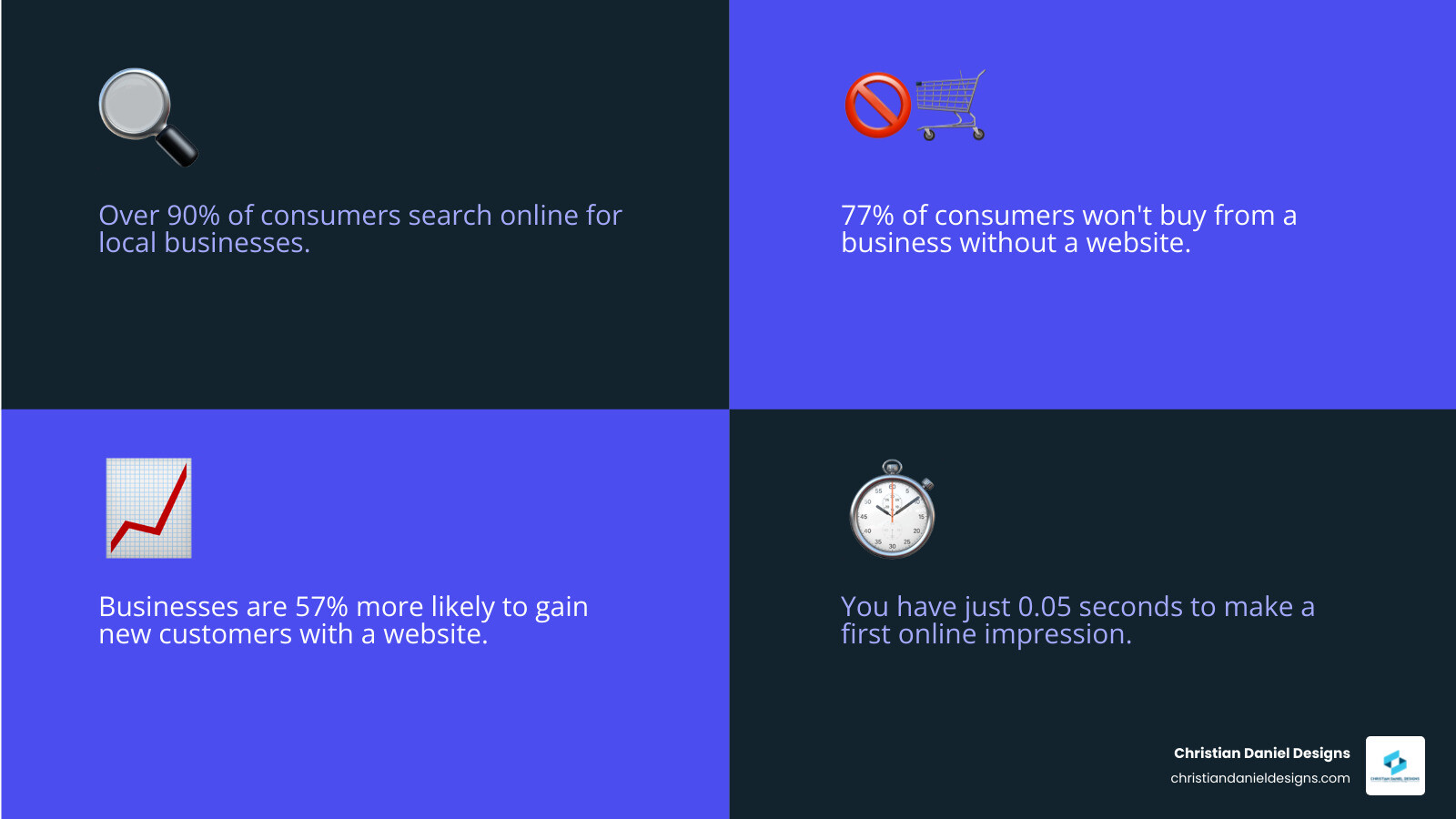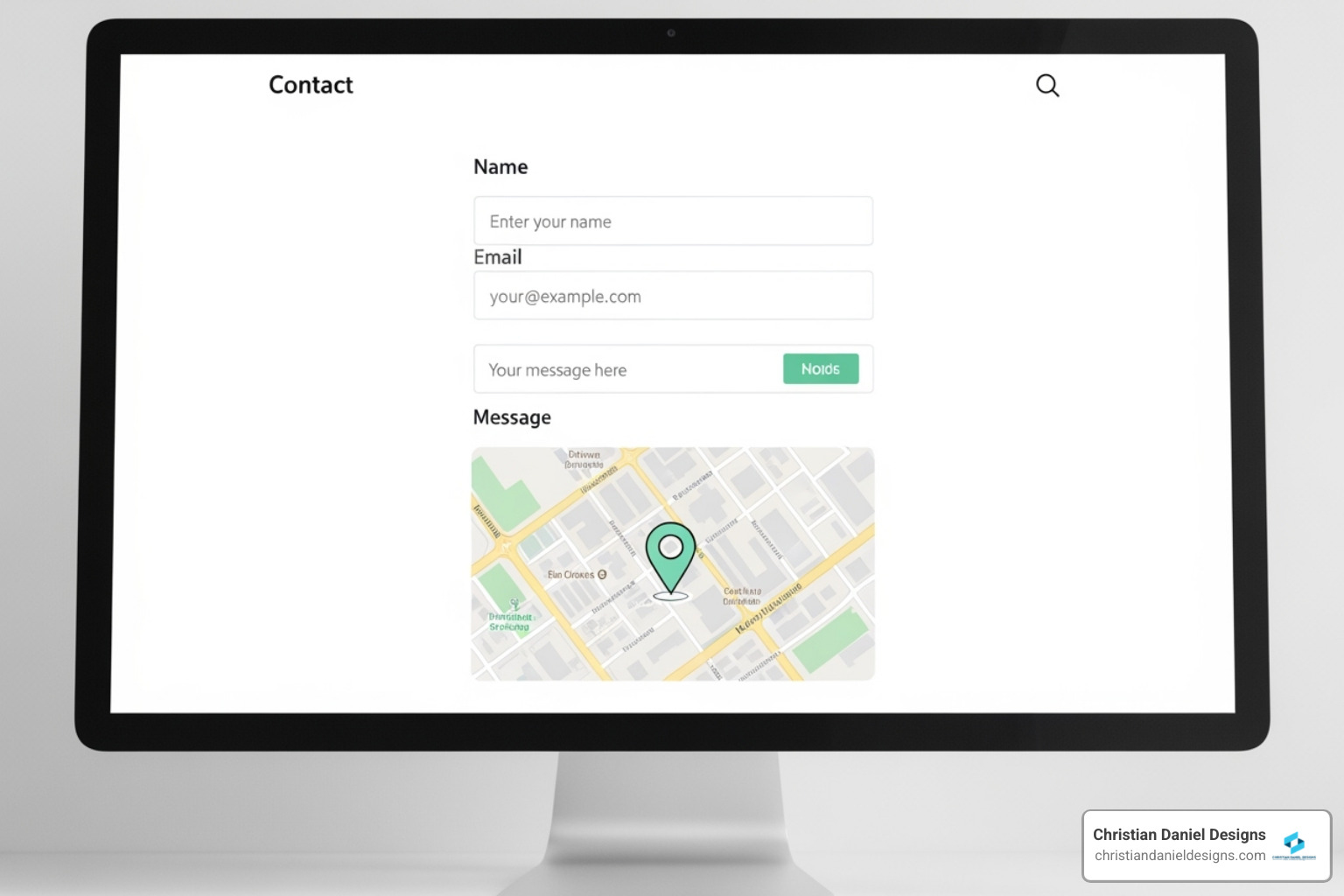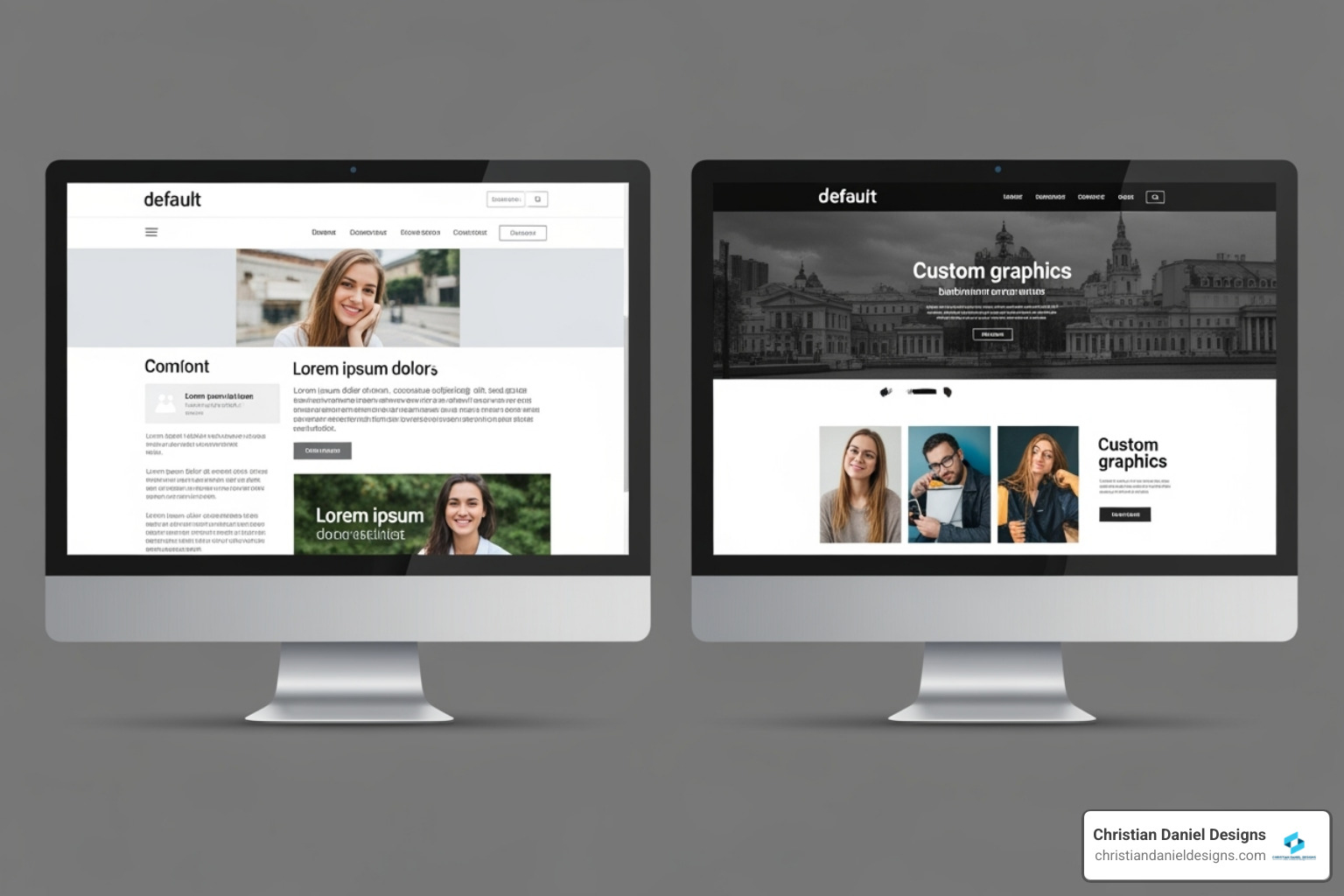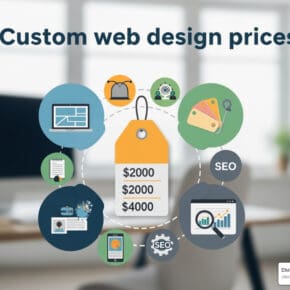Why Your Small Business Can’t Afford to Be Invisible Online
A simple website for small business is no longer optional—it’s essential. Here’s what you need to know:
Quick Answer: Best Simple Website Solutions
- For professional results & best ROI: My custom-designed websites ($10,000+, one-time investment)
- For DIY on a budget: Hostinger ($2.99-$19.99/month) or Mighty Sites ($9/month)
- For creative businesses: Squarespace ($16-$99/month)
- For e-commerce: Shopify ($29-$299/month)
The numbers don’t lie. Over 90% of consumers search online for local businesses, and 77% say they won’t buy from a business without a website. Your website is often the first handshake between you and potential customers—and you have just 0.05 seconds to make that first impression.
But here’s the good news: You don’t need a complicated, expensive website to compete.
A simple, well-designed website can outperform a cluttered, confusing one every time. The key is knowing what features matter, understanding your options, and choosing the right path for your business goals and budget.
Whether you’re considering a DIY website builder like Wix or Squarespace, or wondering if a custom-designed site is worth the investment, this guide will help you make the right choice.
I’m Christian Daniel, and I’ve been designing custom websites for small businesses—especially in hospitality and creative industries—for over 20 years, helping them build powerful online presences that drive real growth. I’ll walk you through everything you need to create a simple website for small business that actually works.

Find more about simple website for small business:
- inexpensive websites for small businesses
- how to find a web designer for small business
- responsive website design
The Power of Simplicity: Benefits of a Simple Website
Why aim for simplicity? Because in a world drowning in digital noise, clarity cuts through. A simple website for small business isn’t just easier to build—it’s often dramatically more effective. After two decades of designing websites, I’ve watched countless elaborate sites get ignored while clean, straightforward ones convert like crazy.
Let me share why keeping it simple is actually your secret weapon.
First, there’s the credibility factor. When someone searches for your business and finds nothing—or worse, stumbles onto a broken, outdated site—alarm bells go off. “Are they even still in business?” A professional online presence, even a basic one, instantly signals legitimacy. The data backs this up: small businesses with websites are 57% more likely to get new customers. Your website tells potential clients, “I’m serious, I’m established, and you can trust me with your money.”
The financial benefits are equally compelling. Simpler websites cost less to build and maintain, which matters tremendously when you’re watching every dollar. Instead of pouring resources into features nobody uses, you can invest in what actually moves the needle—whether that’s better photography, marketing, or simply keeping more cash in your pocket.
Time is another massive advantage. A simple website for small business can go live in days or weeks, not months. I’ve seen business owners stuck in endless revision cycles with complicated sites while their competitors are already capturing leads online. Getting launched quickly means you start attracting customers sooner, and in business, timing can be everything.
Here’s something that surprised many of my clients: simple sites are actually easier to manage. With fewer pages and features, updating your hours, adding a new service, or tweaking your contact information takes minutes, not hours. You won’t need to call your nephew who “knows computers” every time you want to make a change.
The customer experience improves dramatically with simplicity. Think about the last time you visited a cluttered website with dropdown menus three levels deep and pop-ups attacking you from every angle. Frustrating, right? A straightforward site guides visitors directly to what they need—your services, contact form, or that “buy now” button. This clarity doesn’t just feel better; it converts better. Research consistently shows that websites optimized for user experience see significantly higher conversion rates.
Speed matters more than most people realize. Simple sites load faster, steer easier, and feel less overwhelming. When your page loads in under two seconds instead of five, visitors actually stick around. That directly translates to lower bounce rates and more engaged potential customers.
And then there’s mobile. Over 60% of web traffic now comes from phones and tablets, and that number keeps climbing. A simple design naturally adapts better to different screen sizes. Your site needs to work perfectly whether someone’s browsing on a massive desktop monitor or squinting at their phone while waiting for coffee. A recent survey shows consumers trust local businesses with websites more—but only if that website actually works on their device.
Your website is your 24/7 digital storefront. Making it simple, fast, and focused isn’t cutting corners—it’s smart strategy.
Want to dive deeper into my philosophy on effective design? More on my approach to small business design.
Essential Features Every Simple Site Needs
A simple website doesn’t mean a bare-bones one. It means ruthlessly focusing on the core elements that actually serve your customers and drive your business forward. When I design a simple website for small business, these features are non-negotiable:

Clear navigation comes first. Your visitors should never play hide-and-seek with your information. A simple menu—Home, Services, About, Contact—is usually all you need. If people can’t figure out where to click within three seconds, they’ll leave.
Your business name and logo should be prominent and consistent across every page. This isn’t vanity; it’s brand recognition. When someone sees your logo on social media or a business card, they should immediately connect it to your website.
Contact information is absolutely critical. I’m always shocked when I see websites hiding their phone number or burying their email address. Include your phone, email, physical address if you have one, and operating hours. Make it ridiculously easy for people to reach you. Every barrier you remove is another potential customer saved.
A clear services or products list tells people exactly what you offer. Use concise descriptions and high-quality images. Don’t make visitors decode industry jargon or guess what you actually do.
Your About page builds the human connection. People want to know who they’re doing business with. Share your story, your mission, and what makes you different from the competition. This isn’t fluff—it’s trust-building.
High-quality images make an enormous difference. Blurry photos scream “amateur” louder than anything else. Invest in professional photography if possible, or at minimum, use crisp, relevant stock images that reflect your brand. A picture really is worth a thousand words, and a bad one can cost you a customer.
Call-to-action buttons guide people toward the next step. “Call Now,” “Get a Quote,” “Book an Appointment,” “Shop Now”—whatever makes sense for your business. Make these buttons stand out visually and be crystal clear about what happens when someone clicks.
Mobile-responsiveness isn’t optional anymore. Your site must look perfect and function flawlessly on every device, from the latest iPhone to older Android tablets. I test every site I build on multiple devices because this is make-or-break.
Basic SEO elements like title tags, meta descriptions, and clean URLs help search engines understand your site. These aren’t visible to visitors, but they’re crucial for being found online.
Finally, social media links connect your website to your active profiles, fostering community and giving visitors multiple ways to engage with your brand.
Designing for accessibility is crucial. Following Web Content Accessibility Guidelines isn’t just the right thing to do—it’s often legally required and always smart business. An accessible site reaches more people and demonstrates your commitment to serving everyone.
How a Simple Website Drives Growth
A simple website for small business isn’t just a digital brochure gathering dust in some corner of the internet. It’s a strategic growth engine, working around the clock to expand your reach and secure new opportunities. Think of it as your most reliable employee—one who never calls in sick and never stops hustling.
Let me show you exactly how a well-executed simple site fuels business growth.
Attracting new customers is the most obvious benefit. With over 90% of consumers searching online for local businesses, your website acts as a powerful magnet. It’s how people find you when they’re actively looking for what you offer. A clean, intuitive design ensures they stick around long enough to become interested instead of bouncing to your competitor.
Your website becomes the perfect tool for building an email list. Offer something valuable—a helpful guide, a first-time discount, or simply a newsletter with useful tips. That email list becomes gold, allowing you to nurture relationships and market directly to people who’ve already shown interest in your business.
Showcasing reviews and testimonials transforms skeptics into believers. Social proof is incredibly powerful. When potential customers see that other people love working with you, their resistance melts away. I always dedicate prominent space to client testimonials because they do more selling than any marketing copy ever could.
A simple, well-structured website provides the perfect foundation for local SEO. By optimizing your content for local keywords, including your address and phone number consistently, and ensuring your site loads fast on mobile devices, you dramatically increase your chances of appearing when people in your area search for businesses like yours. This is especially crucial in competitive markets like NYC, Jersey City, and Hoboken.
Finally, your website becomes the central hub for all your marketing efforts. Whether you’re running social media campaigns, sending email newsletters, or even placing traditional print ads, your website is where you direct traffic to learn more and convert. Every marketing channel points back to this one destination where you control the message and the experience.
A simple website for small business isn’t the finish line—it’s the launchpad. It’s where you tell your story, showcase your expertise, and make it incredibly easy for customers to say yes.
Ready to explore how video content can boost your site’s engagement? Learn about video marketing for your site.
Comparing Your Options: DIY Builders vs. a Custom Simple Website for Small Business
When it comes to getting a simple website for small business online, you’re essentially standing at a crossroads. Down one path, you’ve got the DIY route with website builders like Wix or Squarespace. Down the other, there’s the professional route with a custom design service (which is what I specialize in). Neither path is inherently “wrong”—but one might be much better suited to where your business is headed.

Let me break down what each option really means for you and your business.
The DIY approach has some obvious appeal. You’re looking at lower monthly costs—usually between $15 and $50 per month—and you don’t need to know a single line of code. You can log in tonight, pick a template, and start building. It’s immediate, it’s accessible, and it puts you in control of every change.
But here’s what I’ve seen happen time and again: those templates can feel limiting fast. You want your site to look a certain way, but the builder won’t let you move that button exactly where you need it. Performance can lag as you add features. And those “low” monthly costs? They add up when you need a custom domain, professional email, better analytics, or any of the premium features that actually make your site work harder for you.
Plus, there’s the time investment. Building a site yourself means learning the platform, making design decisions, troubleshooting issues, and constantly tweaking things. That’s time you’re not spending on what you do best—running your business.
The professional route—custom design—requires a bigger upfront investment. I’m talking $10,000 or more for a quality custom site. That’s not pocket change for a small business, and I get it. But here’s what that investment gets you: a unique design that’s built around your brand, not squeezed into someone else’s template. A site that’s optimized for speed from day one. SEO that’s baked into the foundation, not bolted on later. And scalability—when you’re ready to add e-commerce, booking systems, or more complex features, your site can grow with you.
Most importantly, you don’t need to know anything about code or web design. I handle all the technical details, and once your site launches, managing it is straightforward.
Budget is obviously a factor, but I encourage you to think about value, not just price. A DIY site might cost less per month, but if it’s not converting visitors into customers, what are you really saving? A well-built custom site is a long-term asset that pays for itself by working more effectively.
Your technical skill level matters too. DIY builders are designed for beginners, but there’s still a learning curve. If you’re comfortable with technology and have an eye for design, you might do fine. If the thought of choosing fonts and layouts makes you break out in hives, hiring a professional might save you a lot of stress.
And then there’s scalability. If you’re planning to grow—adding services, expanding your team, integrating with other tools—a custom site is built with that future in mind. DIY builders can grow too, but you might hit walls that require starting over.
The DIY Route: Website Builders (Wix, Squarespace, etc.)
For many small business owners, DIY website builders feel like the obvious starting point. They promise simplicity, speed, and affordability—and for basic sites, they often deliver. Let me walk you through what you’re really getting with some of the most popular platforms. Here’s a quick comparison:
| Platform | Pricing (Monthly) | Ease of Use | Best For |
|---|---|---|---|
| Wix | $17 – $159 | Intuitive drag-and-drop | Businesses needing high customization |
| Squarespace | $16 – $99 | Easy, template-focused | Creative businesses (photographers, artists) |
| Hostinger | Starts at $2.99 | Very simple for beginners | Absolute beginners on a tight budget |
Wix offers hundreds of templates and a flexible drag-and-drop editor, making it a great choice if you want maximum control and don’t mind a bit of a learning curve. It also has an AI builder that can get you started.
Squarespace is my recommendation for creative businesses—photographers, designers, and artists—who prioritize aesthetics. Its templates are stunning, though the editor is less flexible than Wix’s.
Hostinger is the go-to for anyone on a very tight budget. It’s simple and gets a basic site online quickly, but it lacks the polish and advanced features of its competitors.
GoDaddy also offers a builder, often bundled with its domain services, with plans from $10 to $25 per month. It focuses on social media integration, but I’ve found its tools to be less robust than the others.
Here’s what all these platforms have in common: no coding required, which is a huge plus. But they also share limitations—template constraints, potential for slower performance as you add features, and those hidden costs I mentioned earlier. Domain privacy, professional email, premium apps, and removing platform branding all come with additional fees that can quickly double your monthly cost.
For a basic site that you’re willing to manage yourself, these builders can work. Just know what you’re signing up for.
The Professional Route: My Custom-Designed Simple Website for a Small Business
This is where I come in. After 20+ years of designing websites for small businesses—especially in hospitality and creative industries—I’ve seen what works and what doesn’t. And I’ve built my service around eliminating the frustration that comes with DIY builders.
When you work with Christian Daniel Designs, you’re not getting a template that thousands of other businesses are using. You’re getting a unique, brand-aligned design that reflects who you are and speaks directly to your ideal customers. Every element is chosen with intention, from the color palette to the placement of your call-to-action buttons.
Your site will be built for speed and performance from the ground up. I optimize every image, streamline the code, and use best practices that DIY builders simply can’t match. Fast sites rank better in Google, and more importantly, they keep visitors engaged instead of clicking away in frustration.
SEO optimization isn’t an afterthought—it’s baked into the foundation. I structure your site so search engines can easily understand what you offer and who you serve. This gives you a competitive advantage right from launch day.
And here’s something that matters as much as anything: you don’t need any coding knowledge. Not a single line. I handle all the technical details, and once your site is live, managing your content is simple and straightforward.
Perhaps most importantly, your site is scalable for future growth. When you’re ready to add online booking, e-commerce, membership areas, or any other features, your site’s foundation can support it without needing a complete rebuild.
A custom-designed simple website for small business is a true business asset—not a monthly expense, but an investment that works for you year after year. It’s the difference between renting and owning, between making do and having exactly what you need.
Explore my custom web design services to see if this approach is right for your business.





